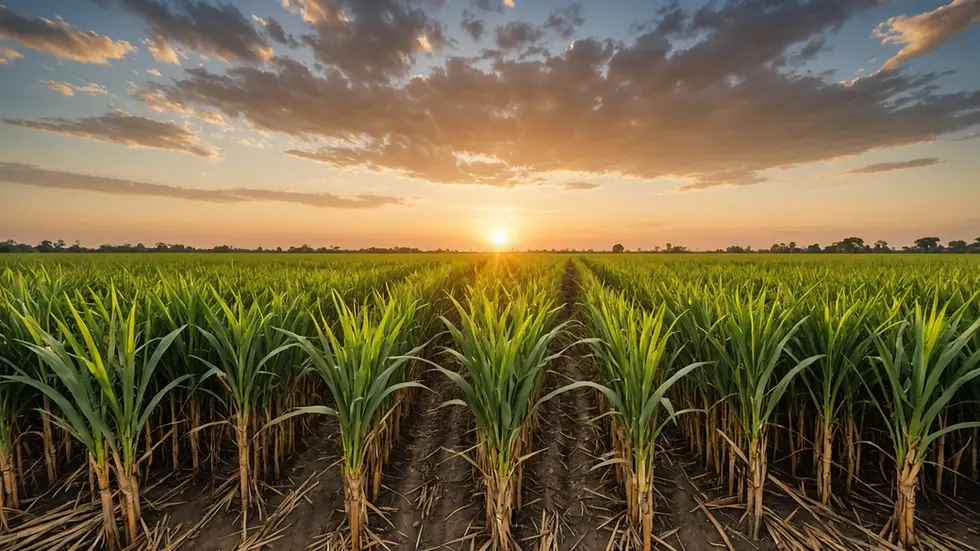Navigating the Path to Effective Bagasse Management: Overcoming Challenges and Achieving Sustainability
- Jugal Vashi
- Feb 25
- 4 min read
Bagasse, the fibrous residue left after extracting juice from sugarcane, presents unique challenges in waste management. As sustainability becomes a priority globally, effective bagasse management is gaining attention. This blog post will explore the hurdles of bagasse management and provide practical solutions to transform these challenges into opportunities for a greener future.
Understanding Bagasse and Its Importance
Bagasse is not merely waste; it is a valuable resource rich in cellulose, hemicellulose, and lignin. These compounds make bagasse a potential feedstock for diverse applications, such as biofuels and biodegradable materials. For instance, studies show that about 40% of sugarcane processed results in bagasse, amounting to millions of tons globally each year. However, mismanagement of bagasse can lead to serious environmental issues, such as air pollution from burning and soil degradation from improper disposal.
The significance of sustainable bagasse management extends beyond waste reduction. It supports circular economy practices, contributes to renewable energy production, and can potentially reduce greenhouse gas emissions by 30% when used effectively.
The Challenges of Bagasse Management
1. Collection and Transportation
Efficiently collecting and transporting bagasse poses several challenges. This bulky material requires specialized equipment and infrastructure for its movement from processing plants to end-users. The seasonal nature of sugarcane harvesting causes bagasse to accumulate quickly during peak periods, creating logistical challenges for organizations.
For example, during the sugarcane harvest in Brazil, which accounts for approximately 25% of the world’s sugar production, more than 250 million tons of bagasse are generated annually. Managing the collection and transportation during this surge becomes crucial for sustaining operations.

2. Storage Issues
Bagasse's perishable nature brings its own set of challenges. Without proper management, it can spoil and attract pests, drastically reducing its quality. The moisture content in bagasse can rise, making it susceptible to mold, which can negate its use in various applications.
Implementing effective storage solutions to control temperature and humidity is vital. For instance, using silos with humidity control features can keep bagasse in good condition, enhancing its usability as a raw material.
3. Developing Value-Added Products
Creating value from bagasse is a complex challenge. Although there is potential for biofuel production, animal feed, and biodegradable packaging, establishing markets for these products requires innovation and investment.
Moving from traditional disposal methods to value-added applications necessitates a shift in industry mindset. According to a report by the Food and Agriculture Organization, converting bagasse into pelleted feed can yield profits upwards of 25% compared to traditional methods. Educational programs are also essential to inform stakeholders about the economic benefits of effectively utilizing bagasse.

Overcoming Challenges: Strategies for Sustainability
1. Leveraging Technology
Utilizing technology can streamline bagasse management significantly. Companies can invest in automation for collection and processing, reducing labor costs and enhancing efficiency.
Additionally, implementing monitoring systems to track moisture levels can ensure that bagasse retains its quality throughout its management cycle. For example, Smart sensors can help producers maintain optimal storage conditions, improving yield quality by up to 20%.
2. Implementing Sustainable Practices
Adopting best practices in waste reduction can elevate sustainable bagasse management. An integrated approach that incorporates bagasse into existing production processes maximizes its utility, minimizing waste.
Collaborating with agricultural waste management firms can create synergies that enhance efficient processing and lower environmental impact. By forming partnerships, organizations can recycle over 70% of bagasse produced, turning waste into valuable resources.
3. Educating Stakeholders
Raising awareness about effective bagasse management is crucial. Educational programs aimed at farmers, processors, and end-users can promote a deeper understanding of sustainability's benefits.
Workshops, seminars, and collaborations with educational institutions can build an informed community committed to optimizing bagasse use. For example, initiatives in India have successfully trained over 10,000 farmers on sustainable management practices, leading to increased income and community involvement.
Noteworthy Success Stories in Bagasse Management
Example 1: Sugar Processing Plant
A sugar processing plant implemented a biogas production facility that uses bagasse as its primary feedstock. This innovative approach not only reduced waste disposal costs but also generated renewable energy for the plant, decreasing energy expenses by 40%.
The success of this facility has encouraged nearby plants to investigate similar ventures, instigating a regional shift toward sustainable practices.
Example 2: Bagasse-Based Eco Products
A company that manufactures biodegradable products successfully launched a new line of packaging derived from bagasse. This initiative caters to the rising consumer demand for eco-friendly products and provides local sugarcane farmers with a steady market for their byproduct.
This mutually beneficial model enhances economic collaboration across the supply chain and stimulates further sustainable practices.
Final Thoughts
Sustainable bagasse management is not just a challenge; it is an opportunity to innovate and create solutions that positively impact the environment and the economy. By understanding the complexities of bagasse management and addressing challenges strategically, stakeholders can transform bagasse from waste into a valuable resource.
As industries embrace sustainability, effective bagasse management will become crucial in fostering resource efficiency and implementing circular economy practices. With consistent commitment and collaboration, the future of bagasse as a sustainable resource looks promising.



Comments